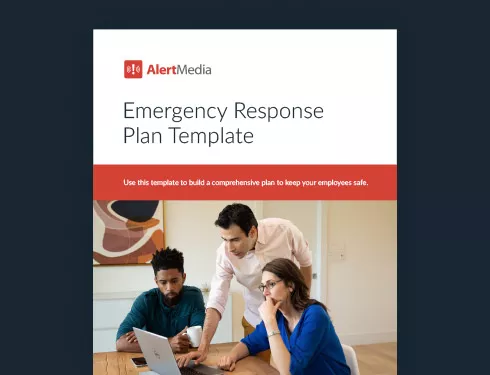
Develop an Emergency Operations Plan to Guard Against All Hazards
To protect your company in an emergency, you need to be prepared for anything. Develop a flexible and comprehensive emergency operations plan with these key strategies.

Imagine if a wildfire, hurricane, or earthquake struck your company’s headquarters. Are you confident that everyone in your organization would know how to respond?
When you imagine those three disasters, you might picture different details. But for a safety leader, the core premise is the same: keeping your employees safe and maintaining business continuity. You can’t always predict the incidents your organization will face. But you can develop procedures to protect your team in any evolving situation. Enter the emergency operations plan (EOP).
As Peter Steinfeld—AlertMedia’s SVP of Safety Solutions—points out, robust emergency management planning focuses not on magic solutions, but on processes. “I think a really great continuity or resiliency manager brings value to the table not by knowing the answer to everything, but by knowing the right questions to ask,” Steinfeld commented. “And they wear glasses that view the world through worst-case scenario lenses. You can go to these experts—who have to keep doing their jobs whether things are good or bad—and have them think about these threatening scenarios.”
Read on to learn how EOPs fit into your organization’s safety procedures and best practices for developing them.
Download Our Emergency Response Plan Template
Understanding Emergency Operations Plans
Emergency operations plans lay out what your organization should do in the event of a disaster. This includes organization-wide directives like incident command at your emergency operations center (EOC) and communication protocols. EOPs also cover department-specific plans like evacuations, equipment management, and critical operations maintenance.
Your EOP should take an all-hazards approach, meaning your team can use it for any type of emergency. However, it should include annexes for specific scenarios your company will likely face. For example, a construction company’s EOP would have an annex for slips and falls, puncture wounds, and other common emergencies on job sites.
The Emergency Management Lifecycle
Your company faces a litany of operational risks that could lead to an emergency. The specific response to each may be different—for example, a fire extinguisher won’t do much good for an infectious disease spread. But, despite these diverse scenarios, every emergency’s lifecycle falls into five phases:
- Prevention: The first step is to take reasonable steps to avoid an emergency. For example, using fire-resistant materials in building construction helps prevent the risk of deadly fires.
- Mitigation: Next, have a mitigation plan to reduce the impact of emergency situations you can’t avoid. If you’re in a tornado-prone area, you can’t prevent them, but you can build a storm cellar as part of a tornado preparedness plan to stay safe when they strike.
- Preparedness: The preparedness phase focuses on gathering the necessary resources to survive a disaster. For example, preparing an emergency supply of food and water to use in the event of an earthquake, hurricane, or other incident.
- Response: The response phase involves implementing plans once an emergency occurs. This could include evacuating, sheltering in place, shutting down heavy machinery, or containing hazardous materials.
- Recovery: Once the immediate threat has passed, your goal is to recover normal operations. Common recovery activities include restarting equipment and inspecting facilities, while extreme recovery measures may include reconstructing buildings or setting up alternate locations to resume business.
EOPs focus on the response effort, but they don’t exist in a vacuum. Hazard mitigation and preparation will guide the assumptions included in your EOPs. And your recovery goals will dictate the potential outcomes you plan for within your larger emergency management program.
Key Components of an Effective EOP
While EOPs all address the same overarching need, they vary widely in scope. Every organization will focus on protecting lives above all else, but that can take various forms. For example, a chain of department stores can focus on evacuating employees and customers in the event of an emergency. In contrast, a hospital will need an EOP that allows personnel to continue caring for patients throughout a disaster.
Despite these variances, all EOPs will contain certain key components:
- Risk assessment: A robust EOP will take an all-hazards approach, providing for any emergency you might face. But focusing on the most realistic and dangerous risks allows you to develop plans suited to your organization’s threat landscape.
- Roles and responsibilities: Your emergency action plan needs to detail who’s responsible for each plan section. It’s also important to include backups for key roles, in case some people are unavailable or unable to carry out their emergency support functions.
- Communication protocols: It’s easy for communication to break down during a natural disaster. Your EOP’s communication protocols should include backup procedures to ensure key personnel can stay in touch no matter how an emergency unfolds.
- Response activities: The response section will constitute the core of your company’s emergency response plan. It should focus on a general approach to emergencies, leaving specifics to appropriate annexes and related planning documents.
- Operational continuity plans: To whatever degree is safe, you’ll want to develop plans to keep business operations running. It’s important to consider the emergency’s impact on external parties like vendors and clients when planning continuity of operations.
- Training and exercises: Practice makes perfect, especially regarding emergency preparedness. Provide regular training on your EOP and run tabletop exercises or emergency drills on procedures such as evacuation.
Best Practices for Developing and Maintaining Your EOP
Emergency operations plans are living documents, in need of ongoing changes and improvement. Here are six ways to create the ideal EOP for your company.
Build preparedness into your organization’s culture
A robust safety culture goes hand-in-hand with operational resilience. By always putting safety first, you instill confidence that you’ll never put employees at undue risk. And in turn, they’ll look out for each other, constantly reinforcing the idea of mutual protection.
In an emergency, that instinctual commitment to safety will be a key asset:
- Employees will be well-trained on plans and procedures
- Everyone involved in emergency response will know their role
- Teams will be comfortable following directions on how to keep themselves safe
- The disaster recovery period will be accelerated as your team knows you’re not rushing back to normal operations before it’s truly safe
As always, it’s also important to foster open, two-way communication. If employees raise questions or concerns about your EOP, take them seriously. Talk through the issues and ensure everyone feels comfortable with your company’s preparedness.
Make your EOP accessible
Before employees can follow a plan, they need to know what it is. You don’t want your employees to have to track it down, so make your EOP widely available.
- Include the base plan in your company handbook
- Make it a part of the employee onboarding experience
- Provide links to the EOP on your company intranet and in safety announcements
- Make it easy for employees to ask questions and provide feedback
To maximize accessibility, communicate in a way that everyone will understand:
- Provide translations if you have employees who aren’t fluent in English
- Avoid using technical terminology in general or basic plans
- Consider creating video or audio content to reinforce key concepts or demonstrate procedures
Audit your plans regularly
Your company’s operations aren’t static. Organizational structures grow, facilities change, and operating procedures evolve—your EOPs must keep pace. For example, say you have detailed fire evacuation plans, but they don’t include a new building on your campus that opened three months ago. Would employees know the post-evacuation assembly point? Who’s responsible for performing a headcount?
This need for regular updates is especially true since the pandemic, as many organizations have workforces more distributed than ever. “As so many people have shifted to hybrid work or fully remote work, all the plans that we’ve put in place for years to deal with any kind of an emergency are probably not going to work so well,” noted Jeff Dow, Manager of Protection and Resiliency at a major financial organization. “When you have that few people, it’s just a whole different element, and you really need to go back and revisit those plans.”
Incorporate lessons from real-life emergencies
The saying “safety regulations are written in blood” might not be true in a literal sense, but it’s not far off the mark. Some of the most important revelations about emergency response come from experience and seeing how plans go astray.
While you’ll always develop EOPs to be as comprehensive as possible, real life doesn’t always conform to expected scenarios. Once imminent danger has passed, it’s important to document what went wrong and how you can improve. Iterating on plans will promote positive outcomes in the future, and hopefully lead to fewer lessons learned the hard way.
Collaborate with law enforcement and first responders
In the event of a local emergency, you’ll probably need help from law enforcement or first responders, such as the fire department, search and rescue, police department, state agencies and emergency medical services (EMS). Developing relationships with these groups early can help them understand your company and how they can assist in an emergency. Familiarizing them with your EOP allows them to provide input and helps you refine internal procedures.
For larger companies or those in public safety sectors like energy or healthcare, collaboration can span several jurisdictions. Along with local connections, you might develop relationships with your state government, the Department of Homeland Security (DHS), the Federal Emergency Management Agency (FEMA), and other federal government groups. Many agencies offer resources to help organizations develop EOPs, including FEMA and DHS. FEMA’s National Incident Management System (NIMS) is also a helpful tool for emergency planning.
Integrate technology for enhanced incident management
In an emergency, every second and every decision counts. Empowering your EOC with technology can give you a critical advantage in collecting, processing, and sharing information:
- Access to human-verified threat intelligence gives you actionable insight to make important choices without sifting through a mountain of public information
- An emergency communication system keeps you in contact with your team, ensuring they have up-to-the-minute instructions to stay safe
- An employee safety monitoring platform helps you keep tabs on at-risk employees and direct help where it’s needed most
- A travel risk management system enables you to communicate with employees who are traveling for work and monitor threats in their area
Ensuring the Best Outcomes by Preparing for the Worst
When disaster strikes, it’s rare that everything will go according to plan. Shifting circumstances and emerging conditions will force you to think and act quickly.
You might not be able to predict every detail. Still, you can control your company’s commitment to safety. By developing a comprehensive EOP, you build a framework to prepare for and respond to any emergency. Even if things don’t go according to plan, you can confidently say you gave your team the tools they needed to protect each other and maintain or recover operations.


![11 Steps to Creating an Effective Emergency Response Plan [+ Template]](https://www.alertmedia.com/wp-content/uploads/2023/10/Blog-Emergency-Response-Plan.webp)

